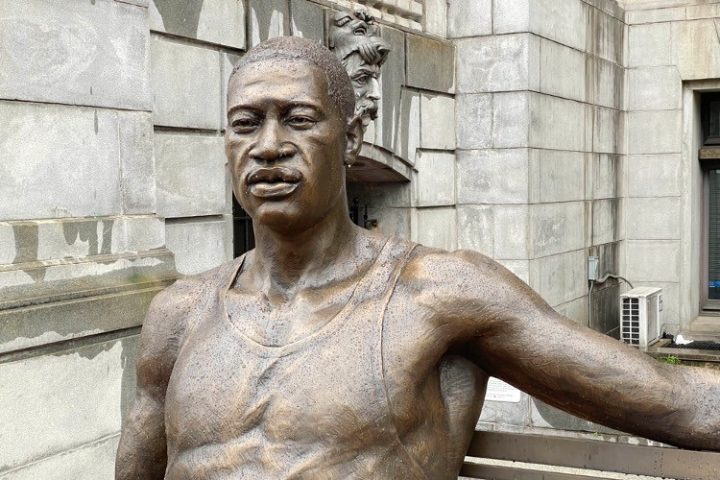
In what could be the most significant literary event of the past half century, Viking Press will publish a biography of George Floyd.
The weighty tome will explain how “systemic racism” led inevitably to his fatal encounter with police in Minneapolis last year. Yet it will also divulge that “one man’s tragic experience brought about a global movement of change,” a news release said.
Two reporters for the Washington Post will pen the highly-anticipated biography. At long last, Floyd will be recognized for his contributions to humankind and take his rightful place at the head of lesser figures such as Lincoln, Churchill, Columbus, and Jefferson.
As for the moral lessons the account of Floyd’s life will impart, if the news release is right, forget the Beatitudes. Even Jesus Christ Himself could learn a thing or two.
“Awakening Millions“
“Placing his narrative within the larger context of America’s deeply troubled history of institutional racism,” the notice from Viking says, “this new book will reveal how systemic racism shaped George Floyd’s life and legacy — from his family’s roots in the tobacco fields of North Carolina, to ongoing inequality in housing, education, health care, criminal justice, and policing — telling the singular story of how one man’s tragic experience brought about a global movement of change.”
Noting that police officer Derek Chauvin “murdered” Floyd — a sickly man who happened to have overdosed on fentanyl, a narcotic 50 times more powerful than heroin — Viking explains that his “death set off a series of protests in the United States and around the world, awakening millions to the dire need for reimagining this country’s broken systems of policing.”
The release suggests the book is even more promising from there:
But behind a face that would be graffitied onto countless murals, and a name that has become synonymous with civil rights, there is the reality of one man’s stolen life: a life beset by suffocating systemic pressures that ultimately proved inescapable.
This biography of George Floyd shows the athletic young boy raised in the projects of Houston’s Third Ward who would become a father, a partner, a friend and a man constantly in search of a better life. In retracing Floyd’s story, Samuels and Olorunnipa bring to light the determination Floyd carried as he faced the relentless struggle to survive as a Black man in America.
The book will also disclose Floyd’s “roots in slavery,” which are likely similar to those of Alex Haley, who told his family’s harrowing yet triumphant history in slavery 50 years ago.
The authors, the release avers, will explain Floyd’s “lasting impact,” and “how a man who simply wanted to breathe ended up touching the world.”
Gun on a Woman
Readers must wait to see if the book discloses the other things Floyd touched, such as illegal drugs and the woman he robbed at gunpoint. The gentle giant almost certainly had a “lasting impact” on her.
The arrest warrant for Floyd, dated November 27, 2007, describes the aggravated robbery that August.
Floyd’s two victims were inside their home “when they heard a knock on the front door,” the warrant explained. Outside was a “a black male dressed in a blue uniform who told her that he was with the water department.”
Floyd ArrestThat was George Floyd, and the two women knew he wasn’t a “water department employee” the minute they opened the door. They tried to keep him out, but Floyd “held the door open and prevented her from doing so,” the record shows.
That when Floyd’s five-man gang showed up in the black Ford Explorer:
The largest of the suspects forced his way into the residence, placed a pistol against the complainant’s abdomen, and forced her into the living room part of the residence. This large suspect then proceeded to search the residence while another armed suspect guarded the complainant, who was struck in the head and side areas by this second armed suspect with his pistol after she screamed for help.
Floyd and his gang were looking for drugs. The victims had none, and so the suspects stole jewelry and a cellphone. When cops finally ran Floyd to ground, they showed his photo to the victims. They identified “Floyd as being the largest of the suspects who initially forced his way into her home, pulled the pistol into her abdominal area.”
Floyd ConvictionThat was only one of Floyd’s nine arrests. He spent nearly a decade in jail and prison.
Floyd RecordOn May 6, 2019, Floyd had a run-in with Minneapolis cops that was remarkably similar to his fatal encounter on May 25 last year.
“Floyd was engaged in the sale and possession of large quantities of controlled substances,” the record shows:
When approached by police he placed drugs in his mouth in an attempt to avoid arrest, and swallowed them. When interacting with police he engaged in diversionary behavior such as crying and acted irrationally. An ambulance was called to transport Mr. Floyd to the hospital….
At which time Mr. Floyd disclosed that he “snorts oxycodone daily,” was hypertensive and not taking medications, took street drugs prior to admission (PTA) and while under arrest was tearful — because he was accused of selling drugs by the police and has been abusing opiates for the last year and a half.
Though the authors of His Names Is George Floyd will divulge his virtues, readers can expect a balanced portrait that takes into account his very few failings, all of which, in the end, grew from “institutional racism.”
The work is likely to become an instant classic, and one of most compelling works since Scribner’s published the first two volumes of Douglas Southall Freeman’s seven-volume masterpiece on George Washington.



